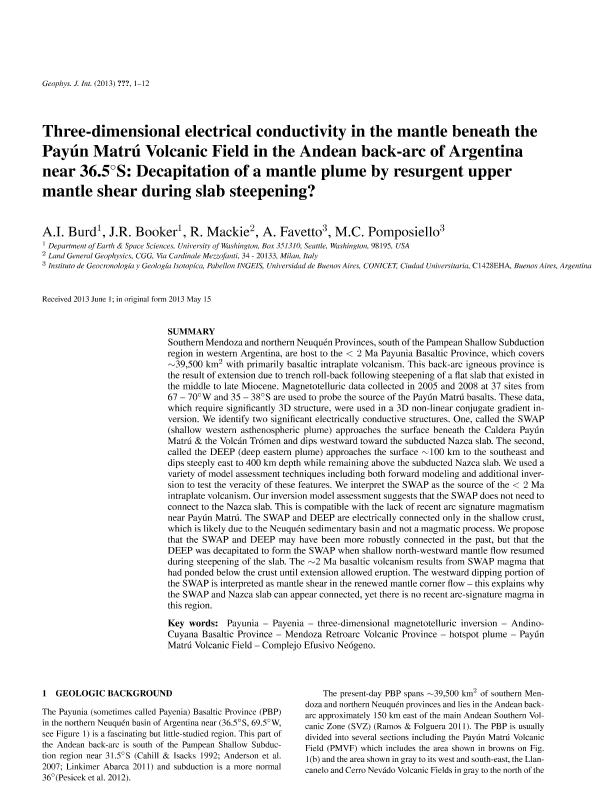Artículo
Three-dimensional electrical conductivity in the mantle beneath the Payún Matrú Volcanic Field in the Andean back-arc of Argentina near 36.5◦S: Decapitation of a mantle plume by resurgent upper mantle shear during slab steepening?
Fecha de publicación:
08/2014
Editorial:
Oxford University Press
Revista:
Geophysical Journal International
ISSN:
0956-540X
e-ISSN:
1365-246X
Idioma:
Inglés
Tipo de recurso:
Artículo publicado
Clasificación temática:
Resumen
Southern Mendoza and northern Neuquén Provinces, south of the Pampean Shallow Subduction region in western Argentina, are host to the <2 Myr Payunia Basaltic Province, which covers ∼39 500 km2 with primarily basaltic intraplate volcanism. This backarc igneous province can be explained by extension due to trench roll-back following steepening of a flat slab that existed in the middle to late Miocene. Magnetotelluric data collected at 37 sites from 67°W to 70°W and 35°S to 38°S are used to probe the source of the Payún Matrú basalts. These data, which require significantly 3-D structure, are inverted with a 3-D non-linear conjugate gradient algorithm that minimizes structure for a given data misfit. We identify two significant electrically conductive structures. One, called the SWAP (shallow western asthenospheric plume) approaches the surface beneath the Payún Matrú Caldera and the Trómen Volcano and dips westward towards the subducted Nazca slab. The second, called the DEEP (deep eastern plume) approaches the surface ∼100 km to the southeast of Payún Matrú and dips steeply east to ∼400 km depth while remaining above the subducted Nazca slab. We use a variety of model assessment techniques including forward modelling and constrained inversion to test the veracity of these features. We interpret the SWAP as the source of the <2 Myr intraplate volcanism. Our model assessment permits but does not require the SWAP to connect to the Nazca slab. The SWAP and DEEP are electrically connected only in the shallow crust, which is likely due to the Neuquén sedimentary basin and not a magmatic process. We propose that the SWAP and DEEP may have been more robustly connected in the past, but that the DEEP was decapitated to form the SWAP when shallow northwestward mantle flow resumed during steepening of the slab. The ∼2 Myr basaltic volcanism is the result of this decapitated DEEP magma that had ponded below the crust until extension allowed eruption. The westward dip of the SWAP is interpreted to be the result of shear in the renewed mantle corner flow—this explains why the SWAP and Nazca slab can appear connected, yet there is no recent arc-signature magma in this region.
Palabras clave:
Magnetotellurics
,
3d Resistivity Model
,
Payun Matru
Archivos asociados
Licencia
Identificadores
Colecciones
Articulos(INGEIS)
Articulos de INST.DE GEOCRONOLOGIA Y GEOLOGIA ISOTOPICA (I)
Articulos de INST.DE GEOCRONOLOGIA Y GEOLOGIA ISOTOPICA (I)
Citación
Burd, Aurora; Booker, John; Randall, Mackie; Favetto, Alicia Beatriz; Pomposiello, Maria Cristina; Three-dimensional electrical conductivity in the mantle beneath the Payún Matrú Volcanic Field in the Andean back-arc of Argentina near 36.5◦S: Decapitation of a mantle plume by resurgent upper mantle shear during slab steepening?; Oxford University Press; Geophysical Journal International; 198; 2; 8-2014; 812-827
Compartir
Altmétricas




